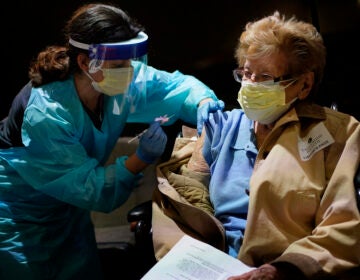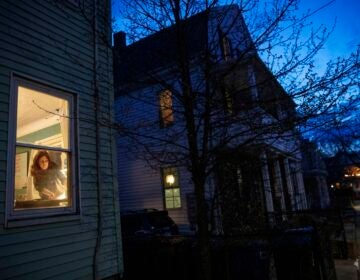Fear of COVID-19 leads people to delay emergency treatment. At times, that’s been deadly
Would-be ER visitors are weighing their fear of worsening symptoms with their fear of exposure to the coronavirus. Doctors say that’s not a good thing.
Listen 1:12
Physicians and nurses in the Doylestown emergency unit Wednesday, May 6. (Courtesy of Thomas DiEnna/Doylestown Health)
Are you on the front lines of the coronavirus? Help us report on the pandemic.
In late April, a patient came into electrophysiologist Melissa Robinson’s lab at UW Medicine at the University of Washington. The patient had experienced shortness of breath; emergency medical services said he probably had COVID-19.
He did not get a test to measure his heart’s electrical signals. He declined to go to a hospital. Later on, he got to an emergency room because he was having more trouble breathing. A few hours later, medical staff found out that what he had was a heart attack, not COVID-19.
“Ultimately at that point, he had a lot of damage already from the heart attack that had been the cause of the issue all along,” Robinson said.
The patient died. He was 44 years old.
“It is very upsetting to see somebody pass away from something that you know one of your colleagues could have fixed if they had presented earlier,” Robinson said. “This is some of the untold burden on medical providers right now, especially those of us who aren’t first responders to [COVID-19] … our hands are tied, we’re sort of at the mercy of the system right now and how patients are coming through.”
Cardiologist James McCabe, a colleague of Robinson’s, said he, too, has seen people coming to the hospital in the later stages of heart disease, and therefore showing up in worse shape. He recalled one recent patient who called his doctor with shortness of breath and a cough and stayed home for several days. The patient had actually had a heart attack.
“When he got to us, we were no longer even focused on heart attack, we were focused on trying to fix the problems that came about because his heart attack had gone all the way to completion and his heart muscle had died,” McCabe said.
Such damage is irreversible. That patient had a prosthetic placed in his heart and survived, but McCabe said the recovery will be complicated. Two similar patients have not survived.
People fear being around other patients in hospitals or spreading a potential COVID infection to first responders — Robinson and McCabe said they understand that. But you still need medical attention if you have difficulty breathing or show other symptoms of a heart attack.
“It’s a delicate balance, because on the one hand we need to keep frontline providers safe,” McCabe said. “But … COVID didn’t put a trademark around shortness of breath.”
An often-repeated scenario
It’s not just heart attacks. At Doylestown Hospital in Bucks County, doctors say they’ve seen the same delayed-treatment pattern with dozens of patients.
When the coronavirus crisis first hit the Philadelphia region in March, there was an overwhelming decline in the number of emergency room cases. Staff were surprised — and worried.
ER cases, by definition, aren’t discretionary; they can’t be put off. So why the drop in caseload? And where were the patients who needed medical attention?
“What we discovered several weeks later was that patients had intentionally delayed care, even for what were potentially catastrophic situations, because of their fear of coming to emergency rooms,” said Scott Levy, Doylestown Health’s chief medical officer.
In other words, would-be ER visitors were weighing their fear of worsening symptoms with their fear of exposure to coronavirus. And often, fear of the virus won.
When incoming patients described the duration of their symptoms to medical intake staff, Levy said, the difference was clear. “Instead of an hour or two of chest pain, it was a week or two of chest pain. Instead of a couple of hours of neurologic changes suggesting a stroke, the symptoms started a week or 10 days ago.”
One patient complained of continued abdominal pain, a common symptom of appendicitis. By the time he arrived in the emergency room, he had developed an abscess and his intestines were perforated. The patient spent six hours in the operating room and three days in the ICU.
Ultimately, he recovered enough to walk out of the hospital, Levy said. “But what could have been a simple appendicitis attack almost took his life.”
José Torradas is an emergency room doctor at another hospital in Bucks County. He said he’s seen stroke patients who have subtle signs like slurred speech or a drooping face yet wait because they don’t want to go to an emergency room and later have major strokes that paralyze half their body.
Another patient had a mild asthma attack, waited “multiple days out of fear of coming to the hospital, then [came] in almost needing to be intubated and put on a ventilator,” Torradas said.
Last month, the American College of Emergency Physicians commissioned a national poll of more than 2,000 adults, and almost one-third reported actively delaying or avoiding medical care because of concerns about catching the new coronavirus.
Several doctors in Italy wrote a letter to the New England Journal of Medicine reporting a 58% increase in cardiac arrests occurring outside hospitals there in the early days of the pandemic, compared to the same time last year.
Melissa Robinson, the electrophysiologist at the University of Washington, said she and her colleagues are working with their emergency medical services partners to make sure people are still looking out for heart disease patients.
The American College of Emergency Physicians partnered with the nonprofit Learning Agency Lab to create a COVID-19 guide that includes information about when people should go to the emergency room.
Medical professionals are so worried about patients delaying emergency care that a group of hospitals in Massachusetts got together to make a public service announcement urging them not to do it.
What if?
Delays in treatment can take a toll on doctors, too, as they wonder what might have happened instead.
Oncologist and hematologist Christina Clay practices in Ohio and the Philadelphia area, and she said a few of her cancer patients who need regular checkups don’t even want to get their blood tested. One didn’t pick up prescribed pills. A particular patient had not gotten a checkup since February, put off visits in March and April, and wanted to delay again.
“I said, ‘No, it’s been three months since we saw you, and I’m not going to prescribe this medicine again without seeing your face,’” Clay said. “She got really angry, said I was endangering her life … by insisting she come in … we agreed to disagree, I put her in for an appointment, and I suspect that she will [be a] no-show.”
That’s an issue, Clay said, because in broad terms for cancer patients who have had surgery, most will be cured, but some will not. For those who haven’t been cured after surgery, some will have the cancer show up again, and others will be cured with medication or chemotherapy. The problem is that doctors cannot predict which patients will need the follow-up treatment and which will not, so they give it to all the patients to increase the chances of curing the cancer.
“That’s why this lady who delayed her treatment … she might have been one of the groups that’s already cured or … it might have made all the difference, and by not getting it, the cancer’s going to come back. That’s why this is all so scary for doctors,” Clay said. “If this lady, God forbid, five years from now, her cancer comes back, we’re always going to wonder: Was she just destined to do that anyway? Or was it because we delayed treatment?”
But as the Philadelphia region looks at reopening, local health systems are seeing a corresponding shift in patient behavior. In the past week or so, Doylestown Hospital has noted a gradual increase in ER numbers. Some of them are patients like Robinson’s and Torradas’, who have delayed care until it becomes absolutely critical, but others are patients seeking medical assistance as usual. That’s due, in part, to deliberate moves by the hospital to separate COVID-19 wards completely, communicate hospital safety policies, and educate unsure patients on the importance of seeking care in a timely way.
“I hope we’ve created the sense that this is a safer environment than what people originally perceived,” Levy said.
Still, the hospital’s numbers aren’t yet quite routine. “Our ER volumes are probably 30 to 35% less than they would be normally, this time of year.”
“What we’ve realized now is that this [virus] isn’t something that’s going to spike and then disappear,” he added. “It has to be part of the way we run a hospital and manage a population … whether that’s a matter of six months, a year, five years, we don’t know.”
In other words, health systems’ approach to the coronavirus pandemic needs to be a marathon, not a sprint.
“We can’t just function around COVID-19,” Levy said. “We have to learn to function, as an organization and a health system, with COVID-19.”
WHYY is your source for fact-based, in-depth journalism and information. As a nonprofit organization, we rely on financial support from readers like you. Please give today.



![CoronavirusPandemic_1024x512[1]](https://whyy.org/wp-content/uploads/2020/03/CoronavirusPandemic_1024x5121-300x150.jpg)




